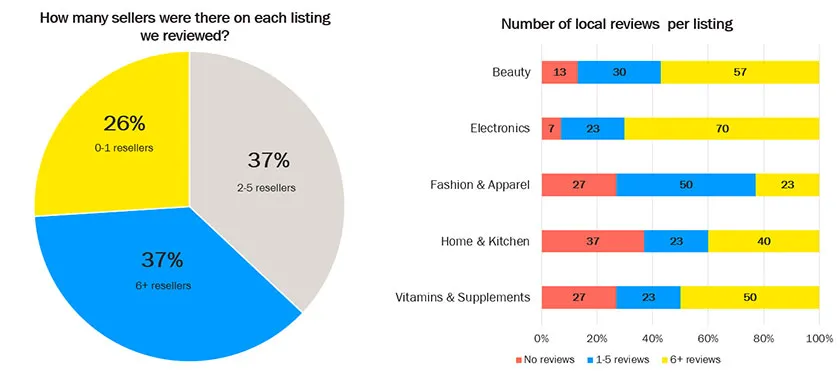Too Many Sellers Impact Amazon.ae Listings
Pattern’s Amazon UAE benchmarking study reveals how too many sellers can impact your Amazon.ae listings, including negative local reviews.

How Too Many Sellers Impact Your Amazon.ae Listings
Too many sellers on listings has begun to become a problem for brands who are represented an Amazon.ae as the traffic and customer demand on the platform has grown. Unauthorised third-party sellers are often undercutting local prices by selling grey market goods or inauthentic product, leading to negative reviews and unhappy customers.
We recently released our Amazon UAE Benchmarking research, analysing the efforts of 50 brands, in five categories, selling on the UAE instance of the platform. From our research we can see the percentage of listings with lots of sellers is relatively high.
Below we outline the scale of the problem of having too many sellers, and how Amazon Advertising can be used to overcome it.
The Impact of Too Many Sellers
Our report covers five top-performing categories on Amazon.ae; Home & Kitchen, Electronics, Fashion & Apparel, Beauty, and Vitamins & Supplements.
It shows that some listings in all categories analysed expect for Fashion & Apparel suffered with too many sellers. 74% of listings had multiple sellers; and more than a third had six or more sellers. And when breaking down per category, we saw Beauty brands faced the most competition on their listings; with 70% of the beauty listings we reviewed having six or more sellers, and 47% of Electronics listings having a high number of competing sellers.

Although competition can be healthy, it can also cause price erosion over time (particularly where third-party sellers are fulfilling orders with grey market product from cheaper markets) and sellers who undercut the competition are the least likely to be willing to invest in great customer service or optimising the listings.
We observed that those listings with a higher number of unauthorised sellers were the most likely to have a damaging amount of negative local reviews, often questioning the product’s authenticity. This was apparent across all categories except for Fashion (Amazon does not allow third-party sellers for some fashion brands). It was more noticeable for brands within Beauty and Vitamins & Supplements, where it is important for customers to be able trust in the product they are purchasing.
Reviews from local customers appear above those from customers in other countries on Amazon.ae, and so though the product may have a good rating and many positive reviews overall, negative local reviews caused by third-party sellers are very noticeable on listings.
There are a few ways to mitigate the impact of too many sellers on your listings. We recommend seeking Brand Registry, so you can control how your listings are changed, and ensure they are optimised at all times.
We also recommend that brands proactively monitor their listings to identify sellers that they don’t have a direct relationship with in the Middle East, and keep an eye on local reviews; as this will highlight if customers are being sold inauthentic product.
Finally, mystery shopping from sellers that you haven’t authorised to sell on Amazon on your behalf can help you to track down the source of the product if it is grey market, and you can also notify Amazon if you find that the seller has supplied fake or out-of-date product. Brands are yet to adopt an Amazon Advertising strategy
Brands are Yet to Adopt an Amazon Advertising Strategy
In our study, we also noted whether the brands reviewed were using Amazon Advertising. The results showed that there is very little competition for either sponsored brand ads or sponsored product ads.

Because of this the cost of Amazon Advertising is still relatively cheap – and the return on investment possible still relatively high – compared to on Amazon in other markets.
Both ad types allow you to raise the profile of your products when customers are searching for what to buy. Using Amazon Sponsored Product ads can also help you to drive traffic to your legitimate listings where Amazon wins the Buy Box (if you have a wholesale relationship with the platform) or your authorised third-party sellers wins the buy Box, if you have a relationship with a business such as Pattern.
In summary, recognising and monitoring whether you have too many sellers on your Amazon listings is the first step in being able to proactively deal with the problem.






